You recently purchased a new vehicle, one you thought was perfect, only to realize that it’s not what you want or need. Does this mean you’re stuck with the vehicle? Not at all. Your best option is to sell your car by trading it in on a new vehicle that better suits your needs, by selling it to a dealership, or by selling it privately.
What’s the best way to sell your new car? It all depends on your preferences and how much time you’re willing to invest. Here’s a breakdown of what you can expect from each option, each of which will help you get behind the wheel of a car you truly love.
Option #1: Trading-In Your Vehicle
Trading in your vehicle is a great option when you’ve found a replacement. Let’s say that you bought a Chevy Equinox, which is stylish and versatile but not large enough for your family’s needs. This led you back to your Chevy dealer to the larger and more spacious Tahoe. Trading in your Equinox for a Suburban is easy and starts with knowing what you paid for the Equinox.
Knowing what you paid or the payoff of your Equinox loan gives you the basis for negotiating a fair trade-in price. Ideally, the offer on your trade will be enough to cover the amount you still owe on the Equinox. If the dealer offers you more than what you owe, this is called positive equity and gives you even more money to put toward the Suburban. Negative equity is when the offer is lower than the payoff, which means you have to cover the remaining balance and take a loss on the vehicle.
Along with knowing the payoff amount on the Equinox, it’s also helpful to know the vehicle’s fair market value. By using the VIN or vehicle identification number, you can venture over to sites like Kelley Blue Book and input the VIN, mileage, and condition of the SUV to determine its value in your area. This is another great starting point for negotiation and gives you a better idea of what you can expect to get for your trade.
Once you wrap up negotiations and accept the offer, it’s all a matter of paperwork. The dealership assumes ownership of your trade-in and will apply the offer as credit toward your next vehicle. In the Equinox-Suburban example, the trade-in is used as credit toward the Suburban. The dealer will then explain your options to finance the remaining balance as well as any available warranty coverage that’s designed to give you greater confidence in your purchase.

Advantages and Disadvantages:
- Pros: Incredibly efficient since you’re relying on the dealership to handle everything, eliminating the need to find a buyer and complete the appropriate paperwork. You’re also never without a vehicle since you’re simply trading in one for another.
- Cons: You might not get the most for your trade since dealers have to factor in their profit margin, which means offers are typically lower than what you might get selling the vehicle privately.
Option #2: Selling to a Dealership
You go to a dealership to buy a car, so why not give the dealer a chance to buy your car as well? Most people don’t think about dealerships buying cars, but how else would they get inventory if they didn’t buy vehicles? Selling your new vehicle to a dealership is a great way to eliminate the hassle that comes with selling it privately and allows you to rely on the experts to ensure all the paperwork is done right.
Selling your new vehicle to a dealership is a lot like the trade-in process with only one key difference–you won’t drive a new vehicle home. Instead of trading in your Equinox for a new Suburban on the lot, you’re simply selling the Equinox and taking home a check. The process, like trading in, starts by knowing the value of the vehicle and the payoff of your loan. This tells you the amount you need to cover the loan and helps you avoid negative equity.
Dealerships expect you to negotiate even when you’re selling your car. Read that again. Dealers will typically start with a low offer, but they know that most customers will ask for more. This is all part of the process and is vital to ensuring you get what you need for your vehicle. To ensure you get the most for your vehicle, take time to have it cleaned or detailed; first impressions mean everything, and a car that needs little reconditioning turns a larger profit.
Advantages and Disadvantages:
- Pros: Dealerships need inventory, so there’s always a demand for vehicles, which means there’s no right or wrong time to sell. It’s also incredibly efficient since dealerships facilitate dozens of sales each week.
- Cons: It takes a little work on your part to get the vehicle ready to sell. You may also have to visit several dealerships before getting an offer that’s best for you.
Option #3: Selling Privately
Selling your vehicle privately is a great option if you’re looking to get more for your vehicle and you’re willing to put in a little extra work. That work starts by making your vehicle more attractive by having it detailed or cleaned to make a lasting first impression. Private buyers are notorious for scouring every inch of a vehicle before they make a purchase, which means you need to look at your vehicle just as they would. Is the upholstery stain-free? Do the heater and air conditioner work? Is there a “Check Engine” light on the dashboard? Are there any dents, dings, or scratches on the exterior?
Getting your vehicle ready to sell can be as easy as having it professionally detailed or might involve taking it to your local mechanic to resolve more complex issues. Once it’s ready to sell, it’s time to start advertising. This might look like posting a “For Sale” sign on the windshield and parking it near the street, or it might mean running ads on social media or in the local newspaper. As people see the ads or the vehicle, you have to carefully screen callers to avoid scammers who simply want to take advantage of you. This part of the process can be tedious when you start having to schedule appointments to look at or test drive the vehicle. It’s also a matter of safety since you’re meeting up with strangers and trusting your instinct when it comes to your well-being.
Potential buyers often plan to negotiate on the asking price with questions like, “What’s the best you can do?” or “What’s the lowest you’ll take?” Instead of offering a price, encourage them to make an offer and go from there. Once you agree on a price, finalizing the sale comes down to completing the required paperwork in your state, such as signing over the title, completing the bill of sale, and signing a release of liability. If the loan is still active at the bank, the bank will likely need to finalize the sale with both parties.

Advantages and Disadvantages:
- Pros: A great way to get more money for your vehicle.
- Cons: Significant investment of time and resources as well as a risk for your safety.
What Option Best Suits You?
Life is too short to drive a vehicle you hate. Whether you’ve had your vehicle a day, a week, or several months, there’s no reason to settle for anything less than what you want. Selling your brand new vehicle is as easy as visiting a dealership to trade it in or sell. You can even take matters into your own hands and sell the vehicle privately. Just remember that, whatever option you choose, know what your investment in the vehicle is and ensure the offer you accept puts you in the clear.



